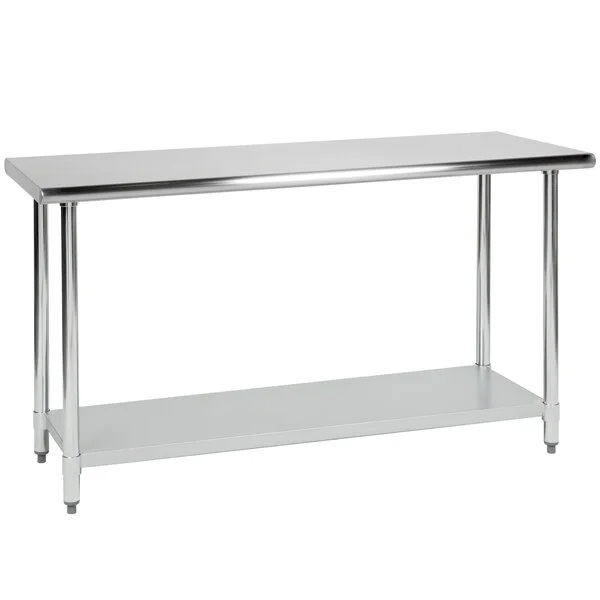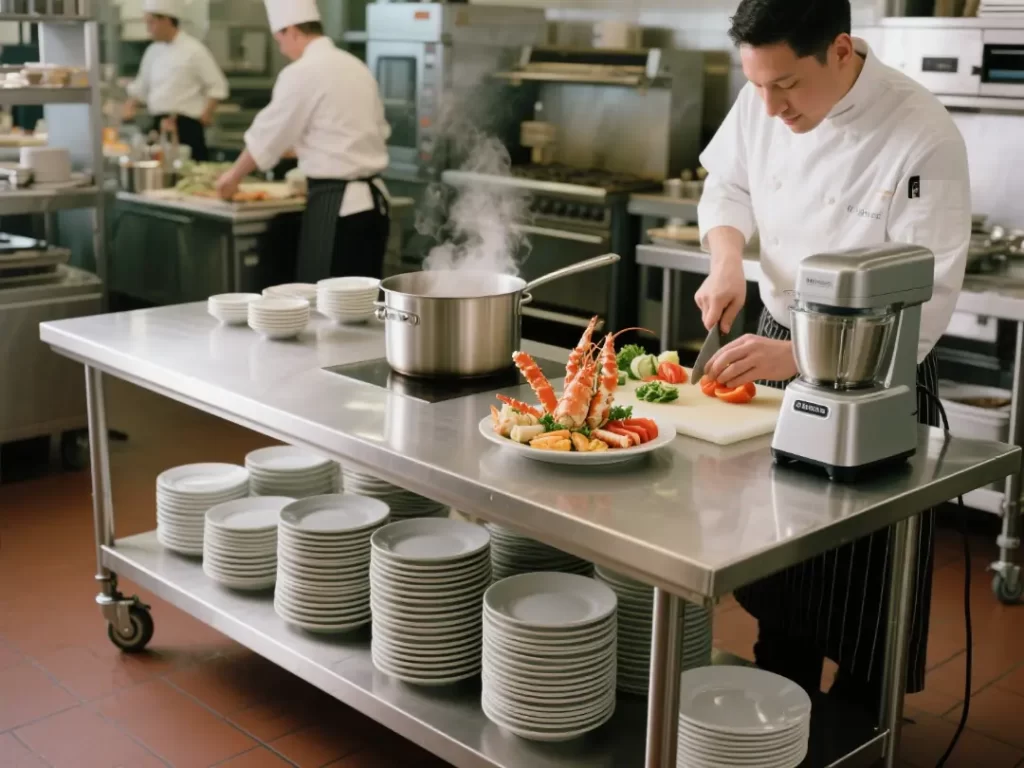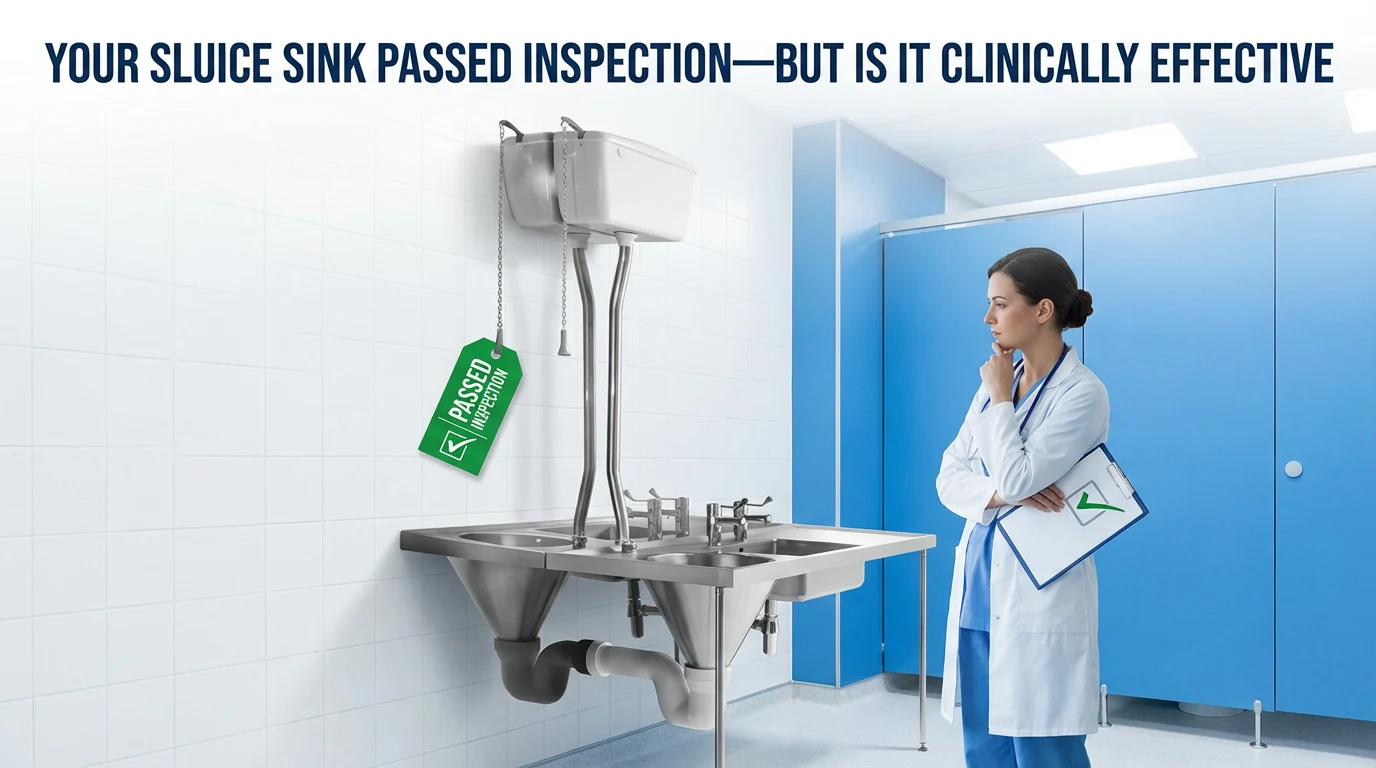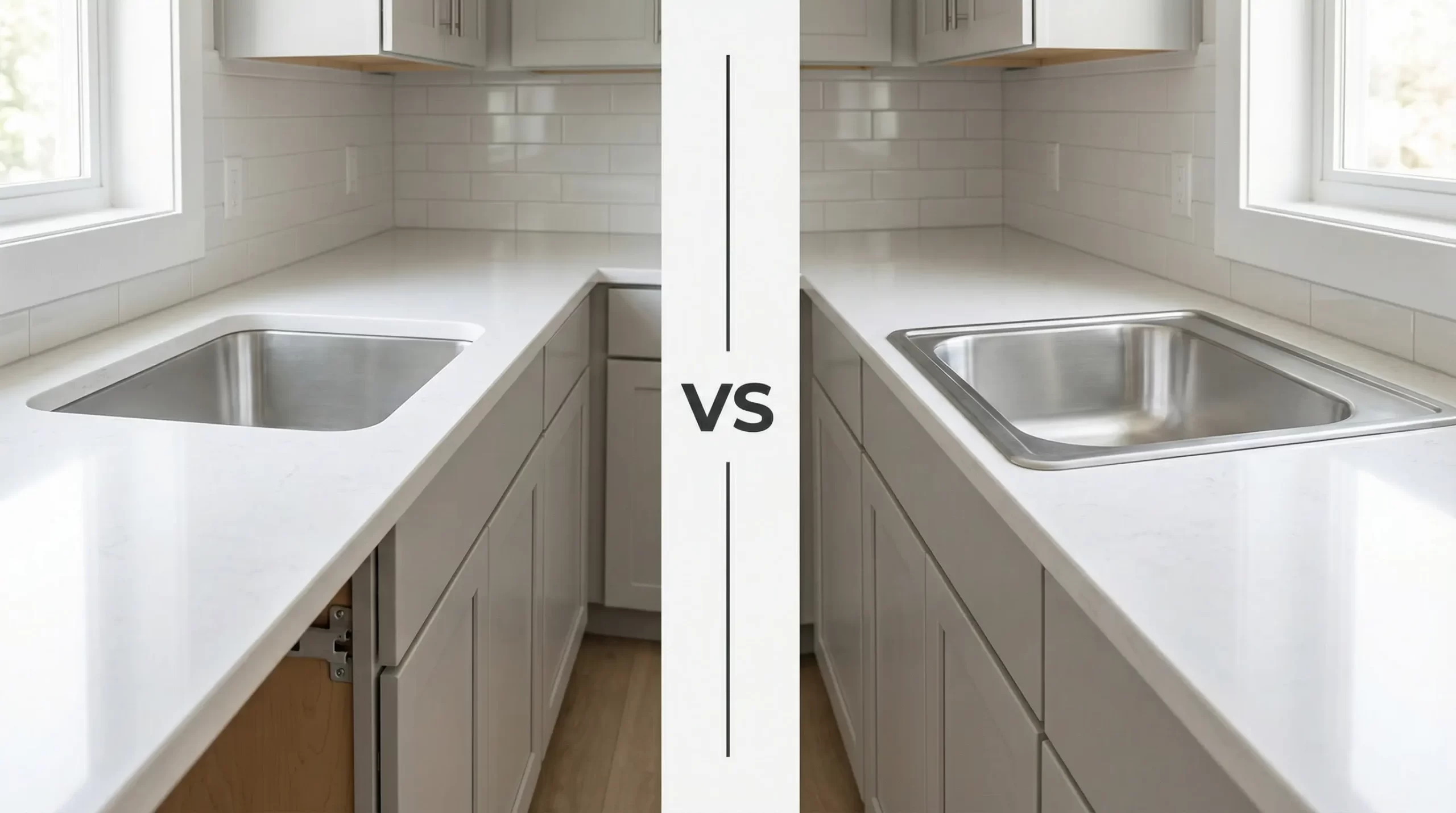Why Do Restaurants Use Stainless Steel Tables
Restaurants love stainless steel tables for their durability (lasting 10-15 years), corrosion resistance, hygiene (under 5% bacteria residue), heat tolerance (up to 1,500°F), fire safety, sleek look, versatility, affordability ($100-$300, $150 over five years), and eco-friendliness (100% recyclable). They’re practical, cost-effective, and a total game-changer.
Durability and Strength
Walk into a buzzing restaurant kitchen, like a burger spot in downtown New York, and you’ll see a stainless steel table holding it down like a champ. These tough tables can take a beating: chefs slicing beef and chopping onions nonstop, plus the occasional 60-pound potato sack dropped fresh from the truck. A 24/7 diner in Chicago has been using the same commercial stainless steel table for 12 years, and it’s still shiny as ever. Wooden tables, though? They’re scratched up and splitting after three years tops.
Kitchens are rough, and gear has to handle constant shuffling and heavy loads. A stainless steel restaurant table’s impact resistance is off the charts—drag a 50-pound mixer across it, no marks; drop a steel pot, just a clang, no dents. Wooden tables crack over time, plastic ones buckle fast, but a stainless steel table stands strong for 10 to 15 years, sometimes more. Stats say wooden tables average 3 to 5 years, plastic ones barely hit 3. With a durable stainless steel workbench, replacements are so rare owners hardly think about it, saving a bundle on swaps.
Then there’s corrosion. Kitchens are chaos—water splashing, grease flying, cleaners everywhere—some places burn through a gallon of bleach daily. Stainless steel tables don’t care; they won’t rust or flake, even with soy sauce spills. Wooden tables soak up water and mold, plastic ones yellow under chemicals, but a commercial stainless steel table’s “untouchable” vibe keeps it kicking. It’s not cheap upfront—say $100 to $300 for a decent-sized stainless steel restaurant table—but over a decade, that’s $10 to $30 a year. Talk about a bargain.
| Feature | Stainless Steel Table | Wooden Table | Plastic Table |
|---|---|---|---|
| Durability | High | Medium | Low |
| Max Weight Load | Over 100 lbs | ~50 lbs | ~30 lbs |
| Corrosion Resistance | Excellent | Poor | Moderate |
| Lifespan | 10-15 years | 3-5 years | 1-3 years |
| Replacement Frequency | Low | Medium | High |

Hygiene and Cleaning
In the U.S., hygiene is everything for restaurants. The FDA and local health folks are always watching, and one “gross” Yelp review can slash your crowd in half. That’s where stainless steel tables swoop in like a lifeline. These sanitary workstations are smooth as glass with no pores, so water, oil, and crumbs can’t sneak in—bacteria’s got nowhere to hide. A UC study found stainless steel kitchen worktables have less than 5% bacterial residue, while wooden tables hit over 50% and plastic ones clock in at 20%. That’s a big deal for keeping food safe.
Cleaning’s a snap. Grab a soapy cloth, wipe it down in 30 seconds, and even burger grease is gone. During a rush, a quick spray of alcohol or bleach makes a commercial stainless steel table germ-free in no time. Wooden tables? You’re scrubbing oil out of the grain forever. Plastic ones get scratched and trap germs no matter what. Stainless steel restaurant tables breeze through health inspections—picky inspectors can’t find a thing to nitpick.
Corrosion resistance adds another layer of awesome. Kitchens use acidic stuff like lemon juice, vinegar, or spicy Texas BBQ sauce, and a stainless steel table doesn’t flinch—no rust, no stains. Wooden tables turn moldy and dark, plastic ones fade under cleaners, but a sanitary stainless steel countertop stays pretty forever. Owners barely spend on cleaning—maybe $5 a year on supplies. Customers see a spotless stainless steel workbench and feel good about their meal, coming back for more.
| Feature | Stainless Steel Table | Wooden Table | Plastic Table |
|---|---|---|---|
| Non-Porous Surface | Yes | No | Partial |
| Bacterial Residue | <5% | >50% | ~20% |
| Cleaning Time | <1 minute | >5 minutes | ~2 minutes |
| Corrosion Resistance | Excellent | Poor | Moderate |
| Health Code Compliance | High | Low | Medium |
Heat Resistance and Fire Safety
American restaurant kitchens run hot—think Atlanta fried chicken joints or Seattle seafood spots packed with sizzling gear. Stainless steel tables don’t even blink; they handle 1,500°F (about 815°C) like it’s nothing. Set a 400°F pizza tray straight from the oven on a fireproof kitchen countertop, and it won’t even blush. Wooden tables char at 300°F, plastic ones melt at 200°F, but a heat-resistant stainless steel table stays cool as ever.
Fire safety’s a huge plus too. With oil popping and burners roaring, things can get wild fast. Stainless steel restaurant tables don’t burn or fuel flames—if a spark flies, they slow it down, buying time to grab the extinguisher. U.S. fire codes are strict, and insurance companies dig a fireproof stainless steel workbench; you might even score a discount. A Texas BBQ owner swears their stainless steel table stopped a grease fire from spreading—total lifesaver.
Chefs love it too. Toss hot pans and trays on it, no coasters needed, no damage done—pure speed during the chaos. Owners rest easy knowing gear won’t fry, risks are low, and customers stay safe. A high-heat stainless steel countertop is the rock every hot kitchen needs.
| Feature | Stainless Steel Table | Wooden Table | Plastic Table |
|---|---|---|---|
| Heat Tolerance | 1,500°F | 300°F | 200°F |
| Fire Resistance | High | Low | Medium |
| Deformation Risk | None | High | Medium |
| Fire Spread Risk | Low | High | Medium |
| Safety Rating | Excellent | Poor | Moderate |
Looks and Professional Vibe
Stainless steel tables aren’t just built tough; they look slick too. Pop one in a kitchen, and its shiny finish and clean lines scream pro vibes. Picture a hot Miami eatery or a gritty Boston bar—the gleaming stainless steel kitchen worktable fits right in with the gear, like something out of a chef’s dream. It’s useful and stylish, no extra decor needed.
Customers notice. In an open kitchen, a spotless commercial stainless steel table blows a scratched-up wooden one out of the water—it’s like a billboard shouting “this place is legit.” Plus, it switches roles easy: a stainless steel prep table today, a serving spot tomorrow, or a dessert display on weekends. Wooden tables get uglier with wear, plastic ones fade fast, but a stainless steel restaurant table wipes clean and looks new for a decade.
For owners, it’s a win. Americans eat with their eyes too, and a sharp, tidy stainless steel countertop ups the cool factor. Customers love it, snap pics for Instagram, and boom—free hype. It’s function and flair in one—who doesn’t want that?
Versatility
A stainless steel table is the kitchen’s all-star. It chops veggies, holds hot pots, plates dishes, and sorts utensils like a pro. It’s sturdy enough for a 60-quart mixer and sleek enough to pile food right on—perfect for showing off a crab leg spread when things get busy. Tiny coffee shops use it as a multi-purpose restaurant tool to save room, big steakhouses pile gear on it—it’s a total workhorse.
Customization’s a bonus. Add a shelf for plates, tweak the height for comfort, or slap wheels on for a mobile stainless steel workbench—food trucks and caterers live for that. One commercial stainless steel table does the job of three, cutting costs and clutter. A Seattle seafood place rigged theirs with wheels, and now prep and service are lightning-fast.
Customers win too. A smooth kitchen means quick food and slick service—better vibes all around. A versatile stainless steel countertop keeps the magic happening behind the scenes, the real MVP.

Cost Efficiency
Stainless steel tables aren’t dirt cheap—$100 to $300 each—while wooden ones go for $50 to $80 and plastic ones hit $30 to $40. But run the numbers: a durable stainless steel table lasts 10 to 15 years, wooden ones tap out at 5, plastic ones at 3. A New Orleans seafood spot’s been using theirs for six years, averaging under $40 a year. Wooden tables would’ve been swapped twice, plastic ones four times—where’d all that cash go?
Maintenance is a breeze. Soap and water clean it up, no wax or fixes, maybe $5 a year on supplies. Wooden tables need oil to avoid cracking, plastic ones get trashed quick, but a commercial stainless steel table keeps going. It’s a jack-of-all-trades too—prep, serve, display—saving you from extra buys. A San Francisco pizza guy says their stainless steel kitchen worktable paid off in three years, enough to grab another oven.
For tight-fisted owners, it’s a no-brainer. Fewer replacements, tiny repair costs, and a kitchen that hums keep five-year costs at $150. Wooden tables hit $120, plastic ones $100, but they don’t last. A stainless steel restaurant table’s a money-saving beast.
| Feature | Stainless Steel Table | Wooden Table | Plastic Table |
|---|---|---|---|
| Initial Cost | $100-$300 | $50-$80 | $30-$40 |
| Lifespan | 10-15 years | 3-5 years | 1-3 years |
| Annual Maintenance | <$5 | ~$20 | ~$15 |
| Replacement Frequency | Low | Medium | High |
| 5-Year Total Cost | ~$150 | ~$120 | ~$100 |
Environment and Sustainability
Green’s the word in the U.S. these days, and stainless steel tables nail it. These eco-friendly stainless steel countertops are 100% recyclable—after 15 years, they melt into something new, unlike wooden tables piling up in dumps or plastic ones with a lousy 30% recycle rate. Good for the earth, easy on the mind.
Durability’s the green kicker. One durable stainless steel table for 15 years means fewer trees cut and less plastic made—huge resource savings. Cleaning’s light too—just half a gallon of water and a dab of soap, no harsh stuff. A Portland vegan spot found their stainless steel kitchen worktable slashed water bills by $30 a year compared to wood.
Customers eat it up. Americans love a business with heart, and eco-friendly restaurant gear might snag you an extra five-star review. It saves dough and looks good—a stainless steel table’s the green win every joint needs.
| Feature | Stainless Steel Table | Wooden Table | Plastic Table |
|---|---|---|---|
| Recyclability | 100% | 50% | 30% |
| Lifespan | 10-15 years | 3-5 years | 1-3 years |
| Annual Resource Use | Low | High | Medium |
| Waste Volume | Minimal | High | Medium |
| Cleaning Water Use | <0.5 gallon | >1 gallon | ~0.75 gallon |






